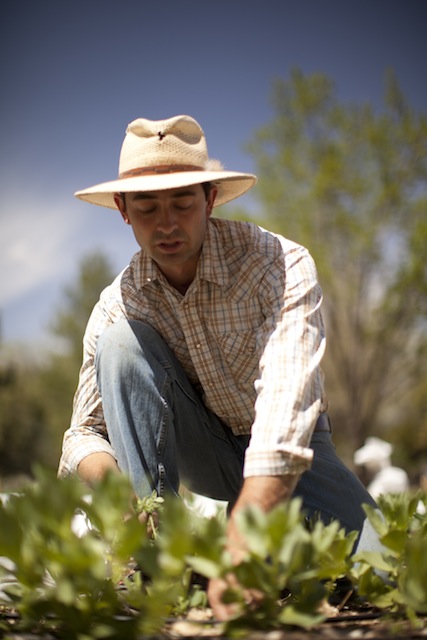
Farmer working in the Los Poblanos Kitchen Garden. Photo courtesy of Josh Hailey Studio.
Biking along the Rio Grande it is quiet, so close but so far from the city. Bosque Forest surrounds the paved path, the mountains providing a contrasting background. Peddling on, the forest soon becomes fields of lavender and wheat, heritage estates, trees with dangling peaches and apples, and rows upon rows of Tempranillo and Cabernet. It’s almost hard to believe I’m in the same city made famous by the illicit endeavors of the fictional Walter White and Jesse Pinkman, but it’s true.
A quiet country retreat isn’t quite the picture shows like “Breaking Bad” and typical media coverage lead you to believe you’ll find in Albuquerque. Tourists flock to the city to visit sites like Walter White’s House, Jesse Pinkman’s RV, and the Crossroads Motel, However, there’s another reason to spend time in this historically and culturally rich city: Agrotourism.
While Old Town is filled with shops and markets and Downtown and Nob Hill feature great restaurants, bars and arts venues, the North Valley is where time slows down, buildings turn to grass and big name hotels become family-run bed and breakfasts.
As you drive closer toward the Rio Grande River Valley, the sounds of the city become quieter and quieter until all you hear is the singing of birds and the plucking of vineyard grapes and lavender throughout flourishing Albuquerque farms.
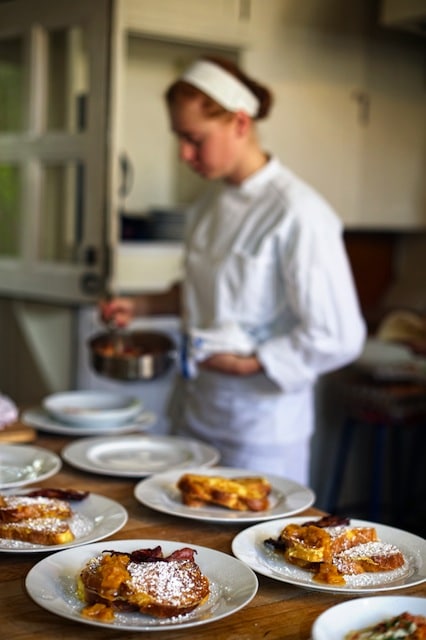
Breakfast being made at Los Poblanos. Photo courtesy of Sergio Salvador Photo.
An Immersive Farmstay Experience
Los Poblanos Historic Inn & Organic Farm represents all that is special about the area in one place, from the rich agricultural heritage to organic farming to working with the local community. Their grounds are the epitome of peace, with 80% of the property dedicated to agriculture. While the land was once inhabited by the Native Pueblo Anasazi Indians, today it is a model experimental farm that allows people to enjoy a farm-stay experience. Along with sleeping in comfortable and rustic farm suites reminiscent of 1930s dairy buildings with pitched tin roofs and white stuccoed walls, visitors can peruse artisanal products in their farm shop, tour the inn’s organic gardens and lavender fields, see farm animals like chickens and goats and enjoy farm-to-fork meals made with organic, locally-sourced ingredients. As you sample dishes like house-made chorizo frittata with seasonal vegetables and buttered hominy and house-made pound cake French toast with seasonal fruit compote, antique mirrors, tin chandeliers, agriculture-themed quilted artwork made by local artisans and fresh-cut sunflowers and peonies immerse you in Los Poblanos culture.
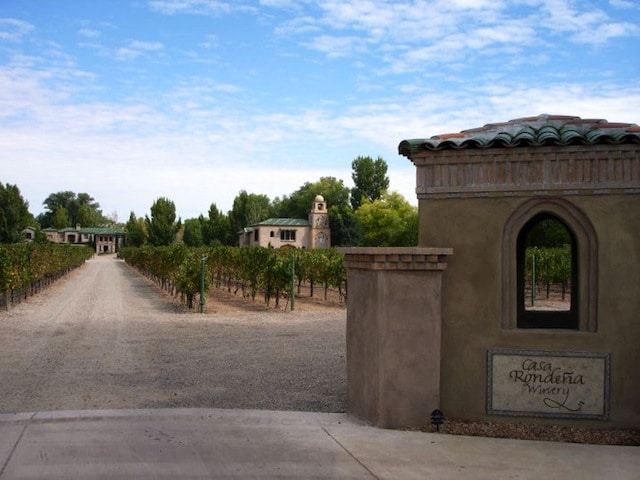
Entering Casa Rondena Winery. Photo courtesy of Casa Rondena Winery.
Wine Touring
From Los Poblanos you can either make use of the complimentary bikes offered to guests or opt for a wine bike tour with Routes Rentals and Tours and explore the many wineries and vineyards that litter the North Valley. What many people may not know is New Mexico is actually the oldest wine producing region in the United States, and has been growing Tempranillo since 1629 when Franciscans needed sacramental wine for communions.
The area is also home to scenic woodland bike trails through the Rio Grande Valley State Park, full of forest, wetlands, nature trails, wildlife, about 370 species of birds and the iconic Rio Grande, which can add to the wine and cycling experience.
After passing fields of corn and chile and well-manicured estate lawns you’ll come to Casa Rondena Winery. Cycle through neat, welcoming rows of Cabernet and Tempranillo before coming to the grand estate itself, composed of four buildings made out of adobe brick. Vintner and architect John Calvin was inspired when living in Southern Spain as well as during his travels around Africa, India and the Middle East, and you’ll see global influences in design and decor throughout the space. Reminiscent of an Andalusian finca (farmhouse), you’ll also find green tiling from Northern Africa and Southern Spain as well as carved stone windows, doors and pillars brought back from Northern India, Pakistan and Afghanistan.
The winery is big on fruit forward wines that tend to pair well with the spicy dishes of New Mexico. It’s good fortune that the state’s hot days and cold nights help sweet wines to grow so well.
A tasting at Casa Rondena Winery begins with their 2010 Meritage, which, according to our wine server, is their most awarded and well-known bottle. A blend of 48% Merlot, 30% Cabernet Franc and 20% Cabernet Sauvignon, it’s complex with flavors of vanilla, currant, blackberry and chocolate and has a lingering finish.
Next we move on to what our wine server believes will eventually become their most popular wine, the 2009 1629. The blend is only two years old, and is an ode to the original wine grapes the Spaniards planted hundreds of years ago. It contains 50% deep, dark Syrah, 41% dense, soft tannins of Cabernet Sauvignon and 9% spicy Tempranillo.
Next it’s on to their 2012 Viognier, a dry white wine with dense flavors of pineapple and honey, with a rich mouth feel and crisp acidity. What people may find confusing about the Viognier is that while it’s a dry white wine it’s also sweet, because when a wine is dry it’s really referring to the fact the wine contains little to no residual sugar after fermentation. This particular wine is also interesting as while it’s really a French grape, it grew so poorly in France it almost became extinct. Luckily, it has flourished in New Mexico and is one of the grapes Casa Rondena Winery is well known for.
After sampling an off-dry 2011 Rose made with Cabernet Franc and a fruity and floral 2011 Serenade made with 87% Riesling and 13% Gewurztraminer, we move on to what is the highlight for me, the 2006 Animante. It’s a deep, elegant port with soft tannins made from Cabernet Sauvignon and Cabernet Franc, which I’m instructed to pair with an indulgent Merlot Chocolate dip. The pairing is pure heaven, just like Albuquerque’s North Valley.
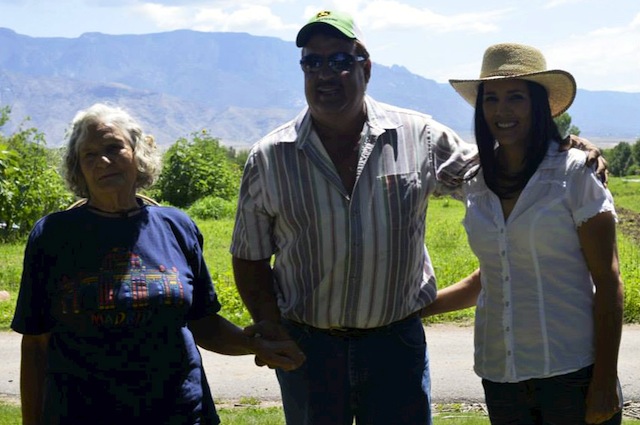
The Wagners with Evelyn Losack
Straight From The Farm
I continue my exploration of the North Valley area with a visit to Wagner’s Farmland Experience. Technically in nearby Corrales, the Wagner’s grow 60 acres (24 hectares) of New Mexico’s 10,000 acres (4,047 hectares) of chile. This is along with numerous other fruits, vegetables, herbs and spices like peaches, apples, melon, green beans, pumpkins, corn and more. According to Roxanne Wagner, despite the fact Hatch, New Mexico, is the chile capital of the world, Albuquerque — specifically the North Valley area — has the advantage of being near the nourishing Rio Grande. Along with showing us around their own crop fields and bringing us to their local farmstand to see fresh chiles being roasted (is there any better smell?), the Wagners introduce me to another local farmer, an elderly woman named Evelyn Losack, who is passionate about growing and eating local. She has me eat cilantro and basil straight from the garden while she talks about how the secret to making jam is to never let the fruit touch water. As she speaks Roxanne stands near her protectively, and you can tell there is a bond between them, the strong friendship of two local farmers working together to create a healthy and sustainable community.
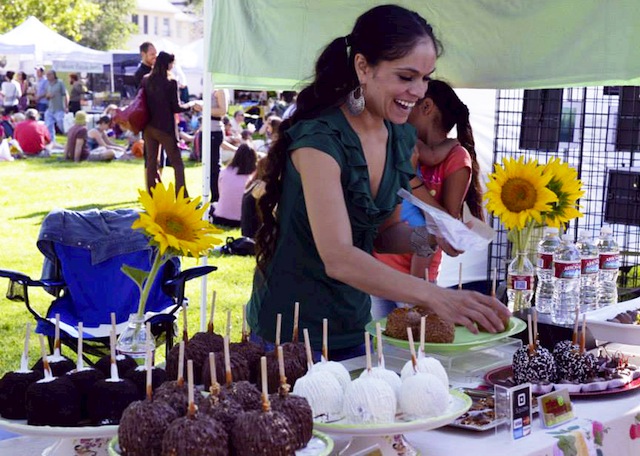
A local vendor at the Downtown Growers Market in Albuquerque.
Community At The Growers Market
The next day is Saturday, which allows me to experience Albuquerque’s delicious farmers’ market culture. On Saturdays from May through November, the Downtown Growers Market — which is in Downtown Albuquerque, although many of the vendors come from the North Valley and surrounding farm areas — brings fresh produce, artisanal pastries, homemade jams and spreads, stinky cheeses, gourmet food stalls and locally-made handicrafts to Robinson Park. My companion and I pool $10 each and with $20 we’re able to create a picnic feast of fresh mozzarella, doughy focaccia, tangy pesto dip, sweet peaches and juicy tomatoes. We bring our meal to the center of the green, where families have all laid out blankets to sit and listen to a local live bluegrass band. The people here are generous, and a woman offers to share her blanket with us. Children hold hands and spin in circles, and a little girl runs up to the band singer and offers him a bite of her watermelon. He ruffles her hair and continues singing.
Community and appreciation. That’s what the North Valley and Albuquerque as a whole is all about. From working together to promote local business to locally sourcing farm fresh ingredients to creating products that are natural and good for the environment and people. It’s about appreciating the simple pleasures in life, the crispness of a just-picked apple, the smell of fresh-roasted chiles, lingering over a long lunch with a neighbor. It’s a side of Albuquerque not many know about, but that’s existed for thousands of years.

Jessica Festa is the editor of the travel sites Jessie on a Journey (http://jessieonajourney.com) and Epicure & Culture (http://epicureandculture.com). Along with blogging at We Blog The World, her byline has appeared in publications like Huffington Post, Gadling, Fodor’s, Travel + Escape, Matador, Viator, The Culture-Ist and many others. After getting her BA/MA in Communication from the State University of New York at Albany, she realized she wasn’t really to stop backpacking and made travel her full time job. Some of her most memorable experiences include studying abroad in Sydney, teaching English in Thailand, doing orphanage work in Ghana, hiking her way through South America and traveling solo through Europe. She has a passion for backpacking, adventure, hiking, wine and getting off the beaten path.








